Connect with our NGS experts today
Want to download this as a PDF? Download now
Contributors
Lyudmila Georgieva1, Ezam Uddin1, Jacqueline Chan1, Faidra Partheniou1, and Graham Speight1
1Oxford Gene Technology (OGT), Oxford, UK
Introduction
- Hybridization-based enrichment protocols for next-generation sequencing (NGS) generate higher quality data (e.g. enhanced coverage uniformity, more complete coverage, and more accurate assessment of insertions/deletions (indels) and internal tandem duplications (ITDs)). However, they are generally more time consuming than PCR-based enrichment approaches.
- We have developed a rapid (30 minute) hybridization protocol that enables Illumina sequencer-ready libraries to be generated from purified DNA in 1-day.
- The aim of this study is to evaluate the new streamlined 1-day hybridization-based NGS library preparation kit (LPK) in conjunction with four different hematological capture panels of varying sizes.
Methods
Preparation of purified DNA to sequencer-ready libraries in 7 hours, 45 minutes
- An enhanced version of the SureSeq™ LPK (OGT) was utilized which incorporates an enzymatic DNA fragmentation in combination with a rapid hybridization of just 30 minutes. This enhanced protocol reduces the overall processing time by 6 hours, resulting in a streamlined, 1-day workflow.
- This kit offers a similar turn-around time to amplicon-based enrichment protocols, without the associated disadvantages, such as PCR bias, allelic bias (indels) and drop-outs, as well as poor uniformity of coverage.
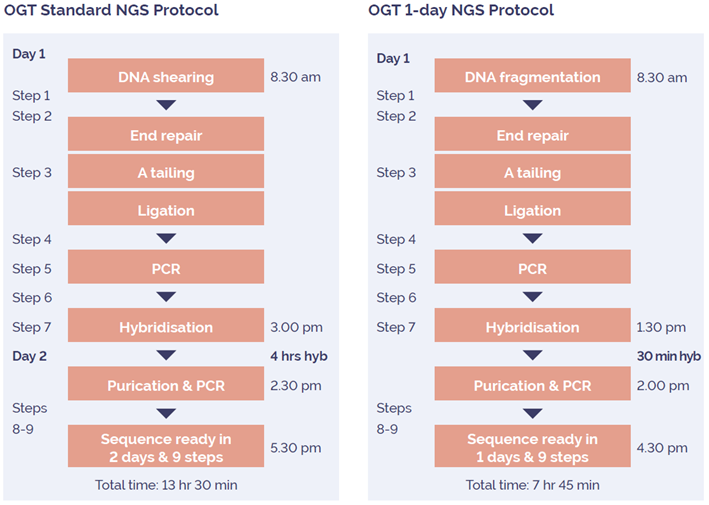 Figure 1: Comparison of workflows.
Figure 1: Comparison of workflows.
Study design
- Four different hematological panels have been used, with a size range from 0.5 Kb to 138 Kb.
- Data quality comparison was performed in terms of Mean Target Coverage (MTC) and % on-target bases achieved with the 1-day and the standard workflow. More specifically, we compared the uniformity of coverage achieved with both protocols for difficult to sequence genes such as CALR, CEBPA and FLT3, as well as the coverage at the key myeloproliferative neoplasm mutation sites: JAK2 V617F, JAK2 exon 12, MPL W515K/L and CALR exon 9.
- Sequencing was performed on a MiSeq® using a V2 300 bp cartridge (Illumina).
 Table 1: Panel names and sizes.
Table 1: Panel names and sizes.
Results
Comparison of the data generated by the 1-day and standard NGS protocols
- Data presented here are from 24* samples that were processed using the enhanced LPK in combination with four hematological panels on an Illumina MiSeq.
- The quality of the data generated with the 1-day protocol is comparable to the standard 4-hour hybridization protocol.
- OGT 1-day protocol generated >85% of the % on-target bases generated with the standard protocol. The % change is consistent for all panel sizes.
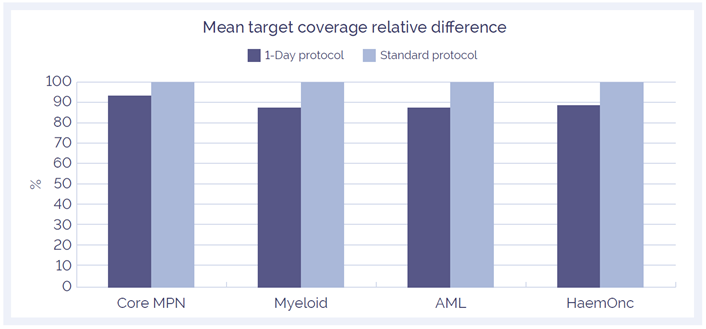 Figure 2: On-target rate comparison between 1-day and standard NGS protocol.
Figure 2: On-target rate comparison between 1-day and standard NGS protocol.
The MTC generated is dependent on the size of each panel. Overall, both workflows generated very good coverage. The MTC generated with the 1-day protocol is >80% of the MTC generated with the standard protocol. The % change is consistent for all panels.
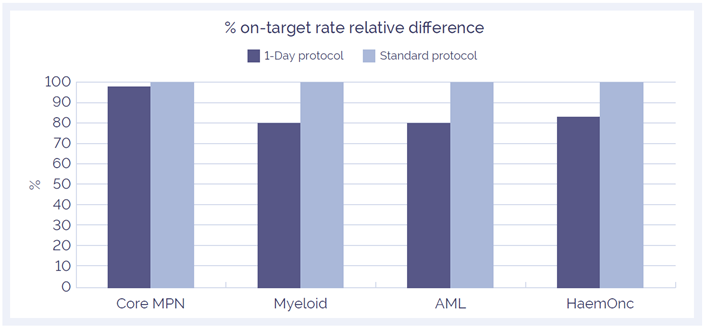 Figure 3: Mean target coverage comparison between 1-day and standard NGS protocol.
Figure 3: Mean target coverage comparison between 1-day and standard NGS protocol.
All panels meet the following uniformity specifications: >99% of bases covered at >20% of the mean (after de-duplication). This permits the reliable detection of more complex rearrangements (i.e.) indels and ITDs.
Accurate and reproducible variant detection even in heterogeneous samples
The SureSeq Core MPN panel has been validated with samples from the National Institute for Biological Standards and Control (NIBSC) and we have shown the accurate detection of JAK2 V617F is possible down to the 1% Variant Allele Frequency (VAF) level at a de-duplicated read depth of >1000x (Table 2).
 Table 2: Data generated from a 48 sample run on an Illumina MiSeq. The SureSeq Core MPN panel in conjunction with the 1-day protocol permitted the detection of alleles at 1% VAF with high confidence.
Table 2: Data generated from a 48 sample run on an Illumina MiSeq. The SureSeq Core MPN panel in conjunction with the 1-day protocol permitted the detection of alleles at 1% VAF with high confidence.
Accurate detection of difficult to sequence genes
Mutations in the CEBPA and FLT3 genes are among the most common molecular alterations in AML. Sequencing of the CEBPA gene is often hampered by a repetitive nucleotide sequence and a very high GC-rich content. Genes such as FLT3 ITDs are challenging to target because they are by nature repetitive, can be long and are generally masked in most panel designs.
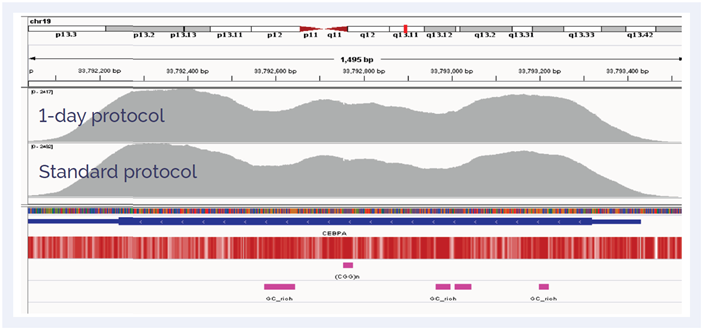 Figure 4: Excellent uniformity of coverage of the CEBPA gene averaging ~2000x coverage. Depth of coverage per base (grey). GC percentage (red). Repeat regions and GC-rich regions (pink). Data shown from 1-day protocol.
Figure 4: Excellent uniformity of coverage of the CEBPA gene averaging ~2000x coverage. Depth of coverage per base (grey). GC percentage (red). Repeat regions and GC-rich regions (pink). Data shown from 1-day protocol.
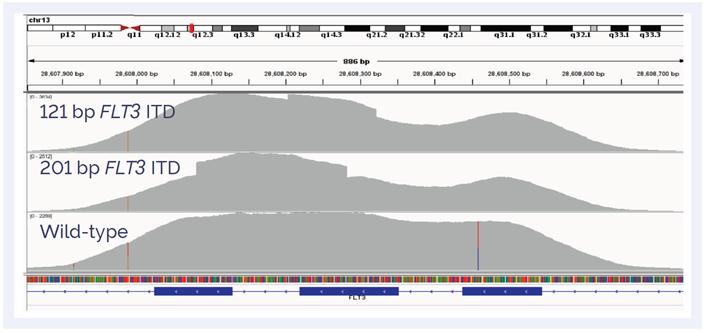 Figure 5: Detection of 121 bp and 201 bp FLT3 ITD. Wild-type sample (bottom panel).
Figure 5: Detection of 121 bp and 201 bp FLT3 ITD. Wild-type sample (bottom panel).
Accurate detection of deletions
Using the enhanced workflow we were able to reliably detect single nucleotide variants (SNVs) as well as insertions (5 bp insertion in JAK2 exon 12 and CALR exon 9) and deletions (5 bp deletion exon 12 JAK2 and 52 bp deletion CALR exon 9).
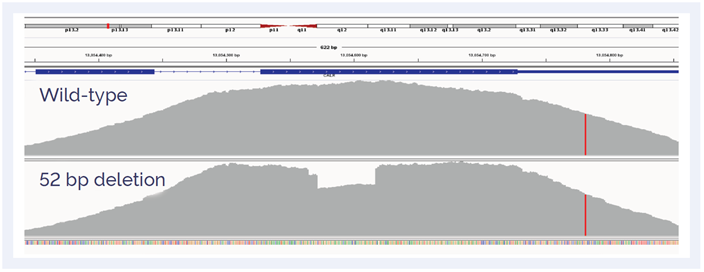 Figure 6: Detection of a 52 bp deletion (exon 9 CALR). Wildtype sample (top panel) is compared to a 52 bp somatic deletion (bottom panel). Data shown from 1-day protocol.
Figure 6: Detection of a 52 bp deletion (exon 9 CALR). Wildtype sample (top panel) is compared to a 52 bp somatic deletion (bottom panel). Data shown from 1-day protocol.
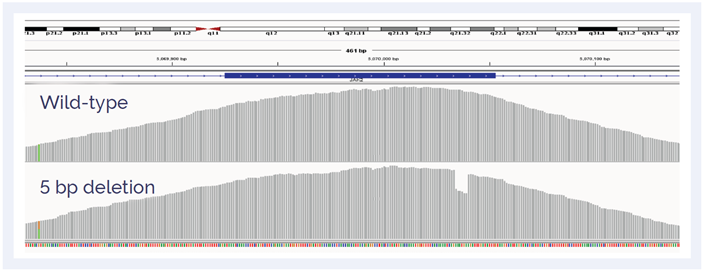 Figure 7: Detection of a 5 bp deletion (exon 12 JAK2). Wild-type sample (top panel) is compared to a 5 bp somatic deletion (bottom panel). Data shown from 1-day protocol.
Figure 7: Detection of a 5 bp deletion (exon 12 JAK2). Wild-type sample (top panel) is compared to a 5 bp somatic deletion (bottom panel). Data shown from 1-day protocol.
Conclusions
- We have successfully utilized the OGT 1-day hybridization-based SureSeq LPK protocol in combination with four hematological cancer panels to reliably and routinely detect somatic SNVs by NGS down to a 1% VAF.
- The uniformity of coverage of this approach permitted the detection of key CALR and JAK2 indels (including 52 bp deletions and 5 bp insertions) and FLT3 ITDs to be identified.
- This enhanced protocol incorporates an enzymatic fragmentation step which permits the high-throughput preparation of 24-48 samples (panel size dependent) from genomic DNA to sequencer in a 1-day workflow.
- To achieve >1000x de-duplicated depth (required for confident detection of 1% VAF), 24-48 samples (panel size dependent) can be reliably sequenced in a single MiSeq (V2 300 bp) run. This allows the generation of high quality data in a cost effective and timely manner.
Acknowledgements
* Samples kindly provided by Prof. Nick Cross, (National Genetics Reference Laboratories - Wessex, UK)
SureSeq™: For Research Use Only; Not for Diagnostic Procedures.
 Figure 1: Comparison of workflows.
Figure 1: Comparison of workflows. Table 1: Panel names and sizes.
Table 1: Panel names and sizes. Figure 2: On-target rate comparison between 1-day and standard NGS protocol.
Figure 2: On-target rate comparison between 1-day and standard NGS protocol. Figure 3: Mean target coverage comparison between 1-day and standard NGS protocol.
Figure 3: Mean target coverage comparison between 1-day and standard NGS protocol. Table 2: Data generated from a 48 sample run on an Illumina MiSeq. The SureSeq Core MPN panel in conjunction with the 1-day protocol permitted the detection of alleles at 1% VAF with high confidence.
Table 2: Data generated from a 48 sample run on an Illumina MiSeq. The SureSeq Core MPN panel in conjunction with the 1-day protocol permitted the detection of alleles at 1% VAF with high confidence. Figure 4: Excellent uniformity of coverage of the CEBPA gene averaging ~2000x coverage. Depth of coverage per base (grey). GC percentage (red). Repeat regions and GC-rich regions (pink). Data shown from 1-day protocol.
Figure 4: Excellent uniformity of coverage of the CEBPA gene averaging ~2000x coverage. Depth of coverage per base (grey). GC percentage (red). Repeat regions and GC-rich regions (pink). Data shown from 1-day protocol. Figure 5: Detection of 121 bp and 201 bp FLT3 ITD. Wild-type sample (bottom panel).
Figure 5: Detection of 121 bp and 201 bp FLT3 ITD. Wild-type sample (bottom panel). Figure 6: Detection of a 52 bp deletion (exon 9 CALR). Wildtype sample (top panel) is compared to a 52 bp somatic deletion (bottom panel). Data shown from 1-day protocol.
Figure 6: Detection of a 52 bp deletion (exon 9 CALR). Wildtype sample (top panel) is compared to a 52 bp somatic deletion (bottom panel). Data shown from 1-day protocol. Figure 7: Detection of a 5 bp deletion (exon 12 JAK2). Wild-type sample (top panel) is compared to a 5 bp somatic deletion (bottom panel). Data shown from 1-day protocol.
Figure 7: Detection of a 5 bp deletion (exon 12 JAK2). Wild-type sample (top panel) is compared to a 5 bp somatic deletion (bottom panel). Data shown from 1-day protocol.